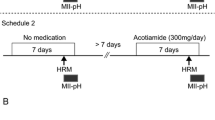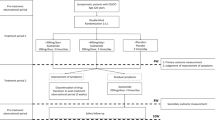Abstract
Background
Acotiamide is a new drug that exhibits prokinetic activity by enhancing the release of acetylcholine. However, its effects on esophageal motility currently remain unknown. Therefore, we herein investigated the effects of acotiamide on esophageal motility in healthy, asymptomatic subjects.
Methods
Thirty healthy subjects received 100 mg of acotiamide or placebo three times a day for 7 days separated by a 28-day washout period in a randomized, double-blind, placebo-controlled crossover study. On the seventh day of treatment, esophagogastric junction pressure, integrated relaxation pressure, and primary peristalsis were assessed using high-resolution manometry.
Results
Esophagogastric junction pressure was significantly higher in the acotiamide group (median 28.2 mmHg) than in the placebo group (24.0 mmHg), whereas no significant differences were observed in integrated relaxation pressure, the distal contractile integral, or contraction patterns between the two groups. Among 13 healthy subjects with peristaltic abnormalities, no significant differences were noted in integrated relaxation pressure or the distal contractile integral between the acotiamide and placebo groups; however, the esophagogastric junction pressure (acotiamide 23.4 mmHg; placebo 21.7 mmHg) significantly increased, the contraction pattern significantly improved, and the frequency of esophageal peristaltic abnormalities significantly decreased in the acotiamide group.
Conclusion
Acotiamide improves the peristaltic pattern in patients with peristaltic abnormalities by decreasing weak peristalsis with a small break.





Similar content being viewed by others

References
Matsueda K, Hongo M, Tack J, et al. Clinical trial: dose-dependent therapeutic efficacy of acotiamide hydrochloride (Z-338) in patients with functional dyspepsia - 100 mg t.i.d. is an optimal dosage. Neurogastroenterol Motil. 2010;22:618–e173.
Tack J, Masclee A, Heading R, et al. A dose-ranging, placebo-controlled, pilot trial of acotiamide in patients with functional dyspepsia. Neurogastroenterol Motil. 2009;21:272–80.
Tack J, Talley NJ, Camilleri M, et al. Functional gastroduodenal disorders. Gastroenterology. 2006;130:1466–79.
Tack J, Janssen P. Acotiamide (Z-338, YM443), a new drug for the treatment of functional dyspepsia. Expert Opin Investig Drugs. 2011;20:701–12.
Ogishima M, Kaibara M, Ueki S, et al. Z-338 facilitates acetylcholine release from enteric neurons due to blockade of muscarinic autoreceptors in guinea pig stomach. J Pharmacol Exp Ther. 2000;294:33–7.
Nakajima T, Nawata H, Ito Y. Z-338, a newly synthetized carboxyamide derivative, stimulates gastric motility through enhancing the excitatory neurotransmission. J Smooth Muscle Res. 2000;36:69–81.
Kusunoki H, Haruma K, Manabe N, et al. Therapeutic efficacy of acotiamide in patients with functional dyspepsia based on enhanced postprandial gastric accommodation and emptying: randomized controlled study evaluation by real-time ultrasonography. Neurogastroenterol Motil. 2012;24:540–5 (e250–e251).
Ishimura N, Mori M, Mikami H, et al. Effects of acotiamide on esophageal motor function and gastroesophageal reflux in healthy volunteers. BMC Gastroenterol. 2015;15:117.
Yamashita H, Kanamori A, Fukuchi T, et al. Novel prokinetic acotiamide reduces transient lower esophageal sphincter relaxation in healthy subjects. Digestion. 2015;92:90–8.
Bredenoord AJ, Fox M, Kahrilas PJ, et al. Chicago Classification criteria of esophageal motility disorders defined in high resolution esophageal pressure topography. Neurogastroenterol Motil. 2012;24(Suppl 1):57–65.
Kahrilas PJ, Ghosh SK, Pandolfino JE. Esophageal motility disorders in terms of pressure topography: the Chicago Classification. J Clin Gastroenterol. 2008;42:627–35.
Kahrilas PJ, Bredenoord AJ, Fox M, et al. The Chicago Classification of esophageal motility disorders, v3.0. Neurogastroenterol Motil. 2015;27:160–74.
Iwakiri K, Kawami N, Sano H, et al. Mechanisms of excessive esophageal acid exposure in patients with reflux esophagitis. Dig Dis Sci. 2009;54:1686–92.
Iwakiri K, Hayashi Y, Kotoyori M, et al. Transient lower esophageal sphincter relaxations (TLESRs) are the major mechanism of gastroesophageal reflux but are not the cause of reflux disease. Dig Dis Sci. 2005;50:1072–7.
Hayashi Y, Iwakiri K, Kotoyori M, et al. Mechanisms of acid gastroesophageal reflux in the Japanese population. Dig Dis Sci. 2008;53:1–6.
Ribolsi M, Balestrieri P, Emerenziani S, Guarino MPL, Cicala M. Weak peristalsis with large breaks is associated with higher acid exposure and delayed reflux clearance in the supine position in GERD patients. Am J Gastroenterol. 2014;109:46–51.
Author information
Authors and Affiliations
Corresponding author
Ethics declarations
Ethical Statement
All procedures followed were in accordance with the approval of the Ethics Committee of Nippon Medical School Chiba Hokusoh Hospital and the guidelines set forth in the Declaration of Helsinki revised in 2000. Informed consent was obtained from all subjects included in the study.
Conflict of interest
Katsuhiko Iwakiri has received lecture fees from Zeria Pharmaceutical Co., Ltd. The remaining authors declare that they have no conflicts of interest.
Additional information
An erratum to this article is available at http://dx.doi.org/10.1007/s10388-017-0576-6.
Rights and permissions
About this article
Cite this article
Hoshino, S., Takenouchi, N., Hanada, Y. et al. Effects of acotiamide on esophageal motility in healthy subjects: a randomized, double-blind, placebo-controlled crossover study. Esophagus 14, 146–152 (2017). https://doi.org/10.1007/s10388-016-0559-z
Received:
Accepted:
Published:
Issue Date:
DOI: https://doi.org/10.1007/s10388-016-0559-z



